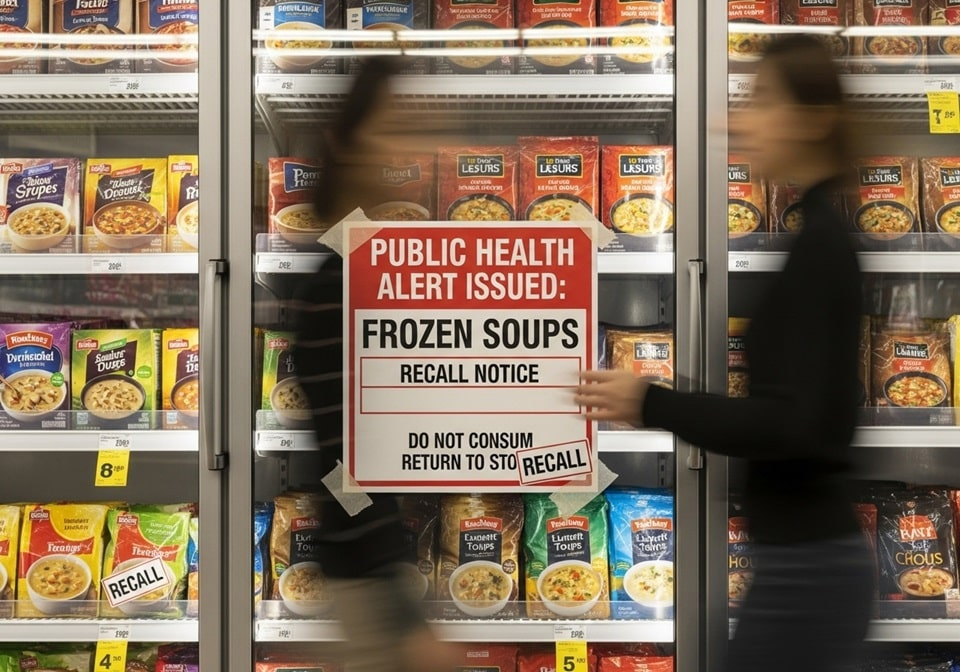
In a significant move to safeguard public health, the U.S. Department of Agriculture’s Food Safety and Inspection Service (FSIS) has issued a public health alert concerning a wide array of frozen soup and bowl products, including those under the well-known **Campbell’s** brand. The alert stems from an unsettling discovery: the potential presence of extraneous material, specifically **wood fragments**, in a cilantro ingredient used in the products. This announcement has sent ripples through the food industry and put consumers on high alert, serving as a stark reminder of the complexities and vulnerabilities within the modern food supply chain. This alert, while not a recall, carries the full weight of a serious warning, as these products may still be present in consumer refrigerators and freezers.
The issue was initially flagged when an ingredient supplier notified the FSIS of a problem with the cilantro, prompting a swift and thorough investigation. This proactive measure by the FSIS is designed to ensure that no consumer is harmed by the products, which have been distributed to retail and institutional locations across several states. The FSIS has a critical role in protecting the public from such risks, and their decision to issue a health alert rather than a recall is a nuanced but important distinction. A recall is a voluntary action by a company to remove adulterated products from the market, whereas a public health alert is issued to inform the public of potential risks when a recall cannot be recommended, often because the products are no longer in commerce but may be in consumers’ homes.
The scope of the public health alert is broad, encompassing products from multiple brands besides Campbell’s, including Verve, Health Request, Molly’s Kitchen, Sysco, and Crafted Market. The affected items, which include various chicken tortilla and other soup varieties, were initially distributed in **Illinois, Indiana, Michigan, and Ohio**. However, the FSIS has indicated that due to the nature of the supply chain, there is a possibility that other products could be impacted, and the alert may be expanded to a nationwide issue. The specific product list, which includes details like lot numbers and “Use By” dates, has been made available on the FSIS website, urging consumers to check their products carefully.
Details of the Affected Products and What Consumers Must Do
The public health alert provides a detailed list of the products that are a cause for concern. These are not the canned soups typically found on grocery shelves, but rather frozen, food service varieties often sold to restaurants and institutions. The FSIS report identifies specific frozen soups, such as Campbell’s Chicken Tortilla Soup and Molly’s Kitchen Baja Chicken Enchilada Soup, by their establishment numbers and use-by dates, providing a clear guide for those who may have purchased them. It is crucial for consumers to pay close attention to this information, as consuming products with foreign material can lead to potential health hazards, including oral injuries or other complications. Consumers who have the affected products are strongly urged not to consume them and should either dispose of the products or return them to the place of purchase for a full refund. This is the most effective way to prevent any potential harm.
The alert underscores the importance of staying informed about food safety notices from government agencies. In a world where supply chains are global and complex, these alerts are a vital tool for preventing widespread public health crises. The FSIS’s proactive approach, in collaboration with the FDA, ensures that even small-scale issues are addressed before they can escalate. This system of checks and balances is a cornerstone of food safety in the United States, providing a layer of protection for consumers who rely on packaged foods for their daily sustenance. The collaboration between government agencies and private companies in these situations is critical to a fast and effective response, which is a topic often covered by major news outlets when discussing regulatory issues. You can find more information about food safety alerts on CNN Health, which regularly reports on such matters.
The Difference Between a Recall and a Public Health Alert
Understanding the distinction between a food recall and a public health alert is essential for consumers. While both are designed to protect the public from unsafe food, they are triggered by different circumstances and require different responses. A **food recall** is a voluntary action taken by a company to remove a product from the market because it is either adulterated or misbranded. This happens when a product has been deemed unsafe to eat, such as in cases of bacterial contamination or undeclared allergens, and the company has chosen to pull it from store shelves and distribution centers. In a recall, the company is responsible for communicating with its customers and recovering the product from commerce. This is a topic that media outlets regularly cover, especially when the issue is widespread. You can find detailed reports on consumer recalls in the business sections of major news organizations like BBC Business.
Conversely, a **public health alert** is a formal communication issued by a regulatory agency like the FSIS to notify the public of a potential health risk in a product that is no longer in commerce but may be in consumer possession. In the case of the soup alert, a recall was not initiated because the products were likely no longer being sold at the retail level at the time the problem was discovered. However, because the products have a long shelf life—some with a use-by date as far out as 2026—there is a significant concern that they may still be in consumers’ homes. The alert is therefore a direct message to the public, advising them to dispose of the product rather than consume it. This type of alert highlights the agency’s commitment to public safety, even when a formal recall is not feasible.
The Broader Context of Food Safety and Supply Chain Vulnerabilities
The recent soup alert is a powerful case study in the modern challenges of food safety. Our global food supply chain is a complex web of producers, suppliers, manufacturers, and distributors, where a single issue at an ingredient supplier can have a ripple effect across multiple products and brands. The cilantro, in this case, was a component in many different soups, which is why the alert covers several brands beyond just Campbell’s. This interconnectedness means that food safety measures must be robust at every stage of production, from the farm to the consumer’s plate. The industry relies on a combination of self-regulation and government oversight to maintain safety standards, and incidents like this serve as a critical reminder of the importance of both. They also highlight the need for greater transparency and communication throughout the supply chain.
Furthermore, this incident provides an opportunity to reflect on the nature of food contamination itself. Contamination with foreign material, whether it be glass, plastic, or in this case, wood, is a recurring issue that poses a physical risk to consumers. While bacterial contamination often receives more attention due to its potential for widespread illness, physical contamination is equally serious. The risk of choking, lacerations, or other injuries is a real and present danger that food safety protocols are designed to prevent. The FSIS alert is a testament to the fact that agencies take these risks seriously, and they work to ensure that all types of contamination are addressed with the same urgency. The consumer response to such alerts is also a topic of media interest, as it often reflects public trust in food brands and regulatory agencies. News from USA Today Money often covers the financial and consumer impacts of these events.
A Closer Look at the FDA and FSIS’s Collaborative Role
The health alert for the contaminated soups is a prime example of the collaborative relationship between the Food and Drug Administration (FDA) and the Food Safety and Inspection Service (FSIS). While the FSIS is responsible for the safety of meat, poultry, and egg products, the FDA oversees all other food products, including the cilantro ingredient that was at the center of this issue. When the FDA’s ingredient supplier notified the agency of the problem, the FSIS was alerted because the cilantro was used in products under its jurisdiction. This cross-agency cooperation is essential to ensuring that all aspects of the food supply are monitored and regulated effectively. The two agencies have clear but distinct roles, and their ability to work together is a cornerstone of the nation’s food safety infrastructure. This collaboration ensures a comprehensive approach to food safety, protecting consumers from a wide range of potential hazards. The ongoing vigilance of these agencies is a core reason why incidents of widespread foodborne illness are relatively rare in the United States.
How Consumers Can Stay Informed and Protected
In the face of an ever-changing landscape of food safety alerts and recalls, consumers must be proactive in protecting themselves and their families. The first step is to stay informed by regularly checking the websites of the FSIS and FDA for the latest advisories. Subscribing to email alerts from these agencies can ensure that critical information, such as the soup alert, is delivered directly to your inbox. Additionally, consumers should always inspect their food products for any signs of tampering or contamination and be vigilant about checking lot numbers and use-by dates, particularly when an alert has been issued for a specific product. Being a well-informed consumer is the first line of defense against potential food-related dangers. In an era of online grocery shopping and home delivery, it is more important than ever for individuals to take an active role in their own food safety.
The Impact on the Soup Industry and Future Measures
The public health alert for Campbell’s and other soups is likely to have a significant impact on the food industry. While the financial repercussions may be limited due to the alert’s specific focus on food service products, the reputational damage could be more lasting. Brands like Campbell’s, which have built a reputation for trust and quality over decades, must act swiftly and transparently to reassure the public that their products are safe. This incident may also prompt a re-evaluation of supplier vetting processes and quality control measures across the industry. Many companies may choose to implement more stringent testing protocols for all ingredients, especially those sourced from outside their direct control. The goal will be to identify and mitigate risks before they ever reach the consumer, turning a reactive response into a proactive one. This push for greater quality control and supply chain transparency is a recurring theme in the food industry, with many companies investing in new technologies to better track their products from source to shelf.
The Broader Picture: Preventing Future Contamination Events
This incident is part of a larger conversation about the future of food safety. As technology advances, so too do the methods of detecting and preventing contamination. From advanced DNA sequencing that can identify pathogens to sophisticated scanning technologies that can detect foreign objects in food, the tools available to manufacturers and regulators are constantly improving. The soup alert, with its focus on a contaminated ingredient, highlights the importance of not just end-product testing, but also thorough testing of all raw materials. This requires a strong partnership between food manufacturers and their suppliers, built on trust and a shared commitment to quality. Moving forward, the industry is likely to see an even greater emphasis on real-time tracking and tracing systems, which would allow for faster and more precise responses to contamination events. These systems, often using blockchain technology, could help to pinpoint the source of a problem in minutes rather than days, drastically reducing the risk to consumers.
Conclusion: A Call for Vigilance and Trust
The public health alert regarding contaminated soups serves as a powerful reminder of the delicate balance between convenience and safety in our food system. It is a testament to the effectiveness of regulatory bodies like the FSIS and FDA, whose quick action is crucial in protecting the public. While the specific products in question may be frozen soups from institutional suppliers, the lessons learned from this incident apply to all consumers. By staying informed, being vigilant, and trusting in the processes that protect our food, we can all play a role in ensuring a safer and healthier food supply for everyone. This incident, while concerning, is also a demonstration of the system working as it should, identifying a problem and alerting the public before any serious harm could occur.





